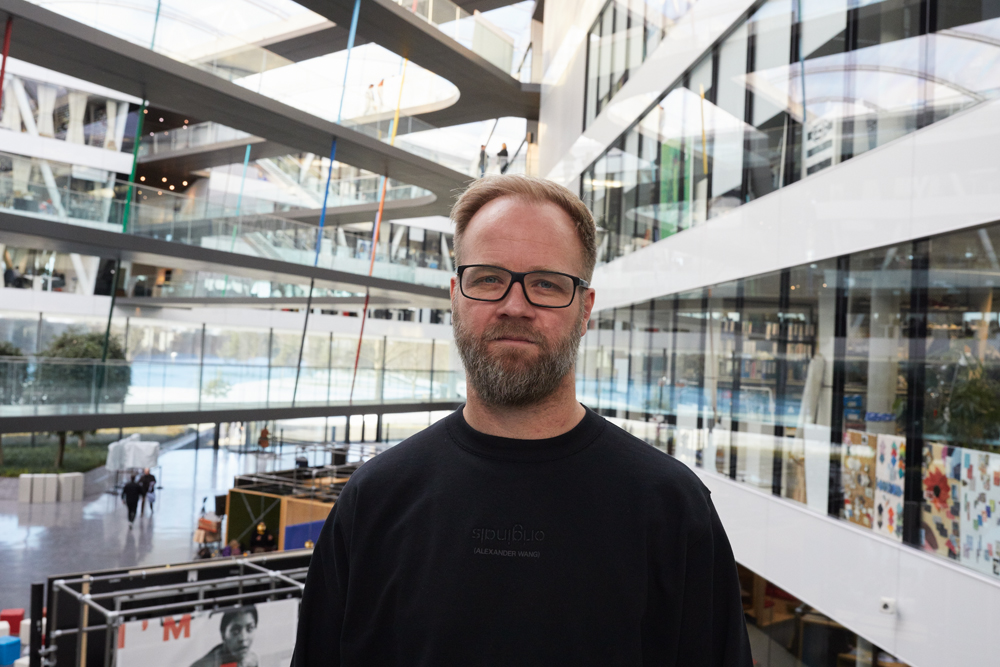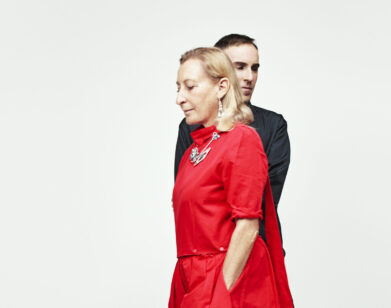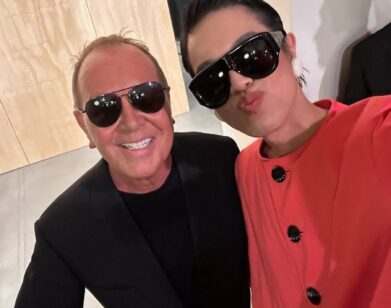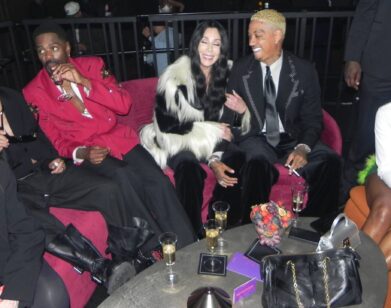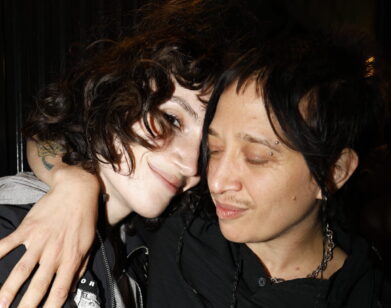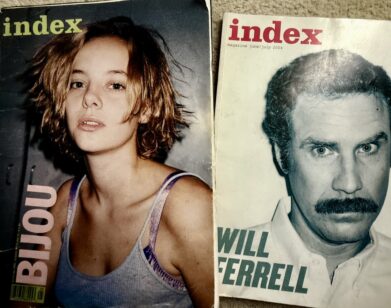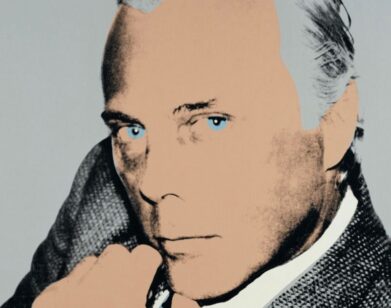Nic Galway
Ever since the early days, the history of athletic wear has been punctuated with vivid and legendary relationships. But no brand has embraced the spirit of collaboration—and reached further into the corners of our culture, searching for talent and vision—quite like Adidas. From Kareem Abdul-Jabbar, who lent his visage to their high tops in the ’70s, to Run-D.M.C. in the ’80s, all the way through to Kanye West and Pharrell Williams today, the German company’s collaborators have consistently redefined the limits of artist and designer, brand ambassador and creator. It’s proved to be rather prescient: lately, in the fashion world and outside of it, the idea of a designer being just a designer, or a musician being just a musician, is not only quaint; it’s limiting. We contain multitudes, as a certain poet once said, and when we unleash them, things like Missy Elliott‘s iconic 2004 knee-high, black-and-gold Adidas sneaker boots are born. Who would’ve thought?
To this lineage add Nic Galway, the British-born, German-based designer, tinkerer and innovator—who, as vice president of global design for Adidas Originals, Style, Y-3, and Core, has been the creative force behind some of the brand’s most successful projects and partnerships in the new millennium. Like many of those he works with, though, Galway, 44, does not come from a fashion background. He studied cars and worked for several years in industrial design. But since landing at Adidas 18 years ago, he’s brought an outsider eye to athletic wear—spearheading innovative materials, new processes, and unexpected collaborations. In 2002, he partnered with Japanese designer Yohji Yamamoto for the Y-3 collection, which is still, to this day, considered a high watermark for designer collaborations. In later years, he’s overseen partnerships with Stella McCartney, Raf Simons, Rick Owens, Kanye West, Pharrell Williams, and Alexander Wang, whom he called recently to discuss collaborating, learning and unlearning, and creativity as a mind-set.
ALEXANDER WANG: I’m excited to be doing this with you. I feel like I’ve had a few questions that I’ve always wanted to ask, but it’s never been the right time. So I guess this gives us the perfect opportunity.
NIC GALWAY: It does, yes!
WANG: I’d like to start with your background. I’ve always found it quite fascinating, your background and your training. And that you didn’t come from the fashion industry. Can you give us some information on what your training and maybe your un-training was?
GALWAY: I grew up in the south of England with no real knowledge of fashion. At that time, I was interested in riding bikes and cars. I studied product design and then I decided to study as an automotive designer. And right about that time, I started rock climbing. Somewhere along the line, I started making things; I started stitching climbing harnesses and stuff like that. And I really enjoyed that. So I was getting into a new sport and was learning how the products of that sport were made. And when it came to do my final project, which was supposed to be a car, I actually ended up designing a hammock for mountaineering. Which was a bit weird, I guess, for the course I was on. Then I got sponsored by a climbing company. They took me into their atelier where they made all their stuff and told me to sew and to make things. From that, I left school and freelanced for a couple of years. Somewhere along the line, I ended up in product design, because I thought I ought to have a bit of cash and do something a bit more serious, if you like. But then I really missed that hands-on, and that took me to Adidas. And, in terms of the unlearning, as you said, that was definitely meeting Yohji Yamamoto, which I had the opportunity to do, really by chance, very early on in my time at Adidas. He saw something he liked in me and invited me to work with him. And that changed everything for me.
WANG: I always find it the most fascinating when people … I don’t want to say stumble but, you know, indirectly end up in a position that they’re so passionate about and become so good at. I know that from our very first conversation, it seemed that you were so knowledgeable and aware of all the aspects that go into design. What would you say are the similarities between what you studied and what you do?
GALWAY: When I worked in consultancy, every project I got was different. I worked on so many things—cars and trams, medical equipment, products. Pretty much anything you can imagine, we would work on. And all that means is that you’re never an expert in any of these things, because you never know what’s coming next. And when you don’t know, in depth, all of the story about something, you come at it from a different angle. Working with Yohji all that time ago, but not really knowing anything about Yohji, that meant that I didn’t get hung up on what people think he should or shouldn’t do. That’s probably what he saw in me; he saw me approaching product in a different way. I think that’s been a common thread. I’ve very much enjoyed my time over the years meeting many, many people, all the way up to when we met just over 12 months ago. And every time being surprised and having something new to learn.
WANG: I definitely can see that. The collaborations that you’ve kick-started there have become such an incredible body of work. How are you able to shift from working with one designer to the next and completely dive into these projects that are so different from one another?
GALWAY: I enjoy collaborations that aren’t surface-deep. Like, when you and I met, I had a first impression of what I thought you would be like. But it’s only when you came to Germany and we spent time in the studio and made things that we really got to know each other. And, to me, that’s what it’s about. I have a very clear rule with myself: there is no fixed way of collaborating. You have to find people who share your values and have a shared ambition. The key is simply to get to know people. It’s a very privileged place for me to be able to work.
WANG: Where do you go for inspiration? What do you do outside of work that really drives you? Besides mountaineering.
GALWAY: It’s an interesting thing, because I never set out to do the job that I do today. I found my way here. But I always wanted to be a creator. I collect a lot of vintage furniture—I like to make things out of that. I’ve never looked at things as being precious. Because, if you buy an old object and you treat it in a precious way … Why would you do that? I love looking around hardware stores or unusual places and reappropriating materials in new ways. I like to keep an eye on what’s going on in the world, in fashion and streetwear and trends, but I don’t tend to use that so much for my own research. It’s just avoiding the temptation of being too absorbed in what’s going on in fashion at any one moment.
WANG: One of the big milestone moments for me is when I was in Germany and you went to the local tool shop and brought back all those random rubber rings and cording and industrial materials. I was like, “Oh, okay, he gets it. He knows where we’re going with this.” [laughs] Something that I see now is that not just fashion designers create brands but musicians, actors, everyone has the opportunity to be his or her own brand today, and you’ve pioneered this way of collaborating at Adidas. Are there any differences between working as a designer or a musician or an entertainer in your previous projects?
GALWAY: I think the key is—regardless of whether it’s a musician or a designer—do they really want to collaborate, or are they looking for something else? Because I’m not interested in endorsements where we just simply pay to use someone’s name or be a manufacturer for someone. That, to me, wouldn’t be a collaboration. So everyone we work with and build projects with, I’m really interested to understand their own creativity. Maybe the difference lies sometimes in how much of my support they might need. But I wouldn’t look at, say, Kanye or Pharrell as musicians; I’d look at them as creators. And I believe they look at themselves in that way. Their understanding of creativity goes far beyond music. And I think, if they have one thing that links them, it’s that they’re amazing collaborators. They both surround themselves with really interesting people from fashion, film, and music, and they don’t draw any lines in that. We’d be in meetings and the room would be full of people from all backgrounds who were there to create. I found that really interesting. And it’s something I brought back into the company—that creativity doesn’t just mean designers. I think it’s a mind-set. That’s what I’ve learned from that. And it’s how I try to approach those projects.
WANG: Is there anyone else that would be a dream collaborator for you?
GALWAY: Yeah, of course. I’ve been on this incredible journey for 18 years. I’d like to get a good balance between the bigger names and the up-and-comers. I’d like to break down stereotypes and show creativity in different ways. And while there are so many people I’d love to collaborate with in the future, what I’m actually really proud of is the duration of our collaborations and how authentic they are. I’m very proud that I’ve worked with Yohji since 2000. That’s important. Because you know how it is today; there are so many collaborations that come and go in one year.
WANG: They’re so fleeting.
GALWAY: Yeah, it’s a bit opportunist. And, as I said, I like to get to know people. You and I have been working together for a while now, and I think the best collaborations are the ones you build over time. So, for sure, I always have my eyes open. I never want to get in one fixed past. I like to keep things shaken up.
WANG: Shall we get a little personal? [both laugh] What are some of your pet peeves?
GALWAY: Hmm … I mean, I work in a very big corporation, and that allows me to do what I love to do, but red tape can frustrate me. As you know—you’ve worked with me—I’m not someone who says no very often. If I do say no, it’s because I simply can’t do it. So people who are too quick to say no, or it’s been done, or we’ve already tried it, or that’s how it is—that doesn’t work for me. I’m someone who will do whatever it takes. And I have to surround myself with people who think like that.
WANG: Giving you a big round of applause right now because you’ve been such an advocate for innovation, to try new ideas, and that’s not always the case.
GALWAY: That’s very nice of you. That, for me, is the key. I work in an iconic brand. That’s why I’m here. I love this company. But I’ve got to use my time to do something with that opportunity. And of course, it’s easier to stick to the rules, but when you take these challenges, we can really create momentum. That’s why I do it. It’s not to be difficult, but it’s because I believe in our potential. There’s no point in me wanting to collaborate with you, and then when you have an idea, saying, “No, we can’t do that.” I always take on the challenge.
WANG: What’s the best professional advice you’ve ever received, and who gave it to you?
GALWAY: That’s interesting. I’m sure there are lots that I’m completely blanking on. But I always remember a quote from Yohji—mainly because Yohji doesn’t say much, and when he says something, it means something. He always used to say to me, “It’s too noisy.” This was his thing. And what he meant by that was, “You have too many ideas. They’re good ideas, but you have too many of them.” And that was his way of saying, “What do you really want to say?” I’ve always taken that with me. He used to say that to me quite regularly, less so these days. But I thought it was good because, as a designer, you’re sometimes in such a rush to get all of your ideas out at once, and while you think every idea is so important, sometimes the more you put in, actually, the less people get out of it. And he was very good at just saying, “Take one of those ideas and that’s enough.” If I think of the most successful sneakers that I’ve worked on in my time, they are the ones that have one really strong, clear idea. It’s a very small piece of advice, but it changed my journey. Without those early meetings, we probably wouldn’t be having this conversation. I might be talking to someone about cars or something.
ALEXANDER WANG IS A NEW YORK-BASED FASHION DESIGNER, AND THE FORMER CREATIVE DIRECTOR OF BALENCIAGA. HIS CAPSULE COLLECTION WITH ADIDAS DEBUTED THIS PAST SEPTEMBER.

